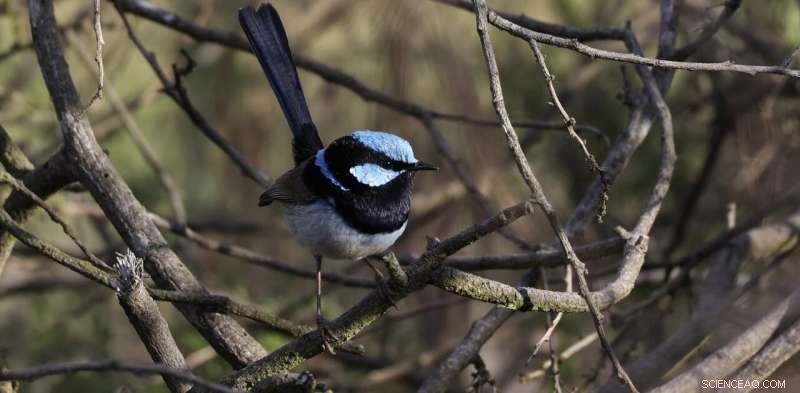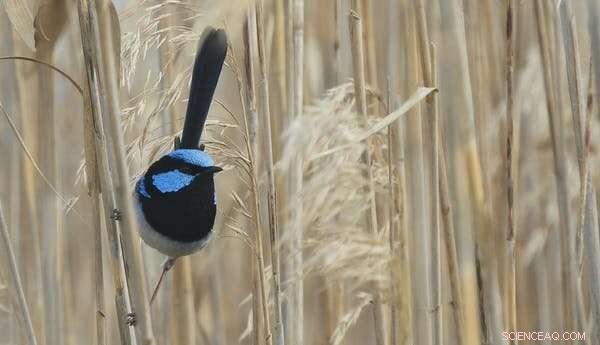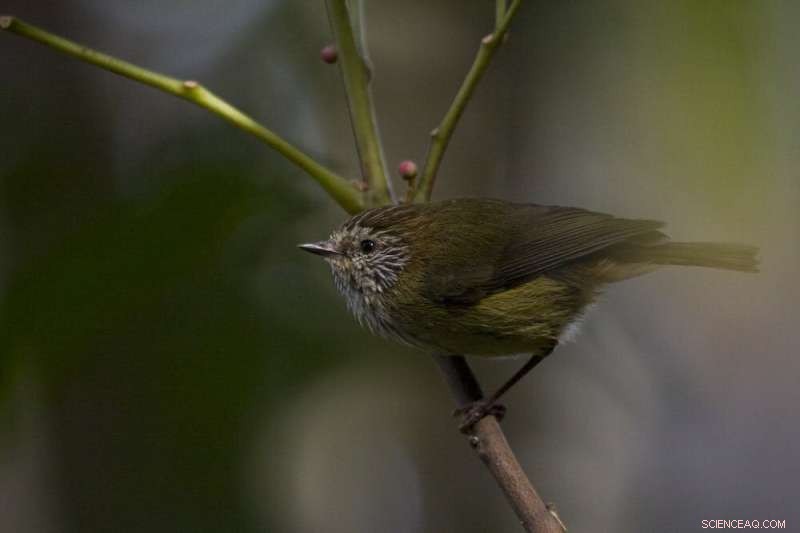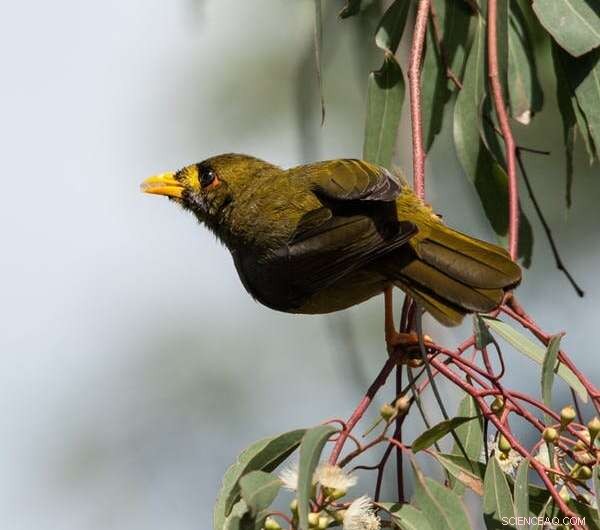
Credito:Kaspar Delhey, autore fornito
Un mistero che molti biologi vogliono risolvere è come si sviluppa la complessità in natura. E tra i tanti sistemi sociali nel mondo naturale, le società multilivello si distinguono per la loro complessità. Gli individui prima si organizzano in famiglie, che sono membri di bande, che sono organizzate in clan.
Ad ogni livello, le associazioni tra le componenti (individui, famiglie e clan) sono strutturate e stabili. In altre parole, gli individui all'interno delle famiglie di solito stanno insieme e le famiglie di solito interagiscono con altre famiglie specifiche in modo prevedibile, per formare clan stabili.
Tale organizzazione sociale ha probabilmente caratterizzato gran parte dell'evoluzione umana (ed è ancora comune in molte società di cacciatori-raccoglitori in tutto il mondo).
In effetti, le società multilivello hanno probabilmente svolto un ruolo fondamentale nella storia umana, accelerando la nostra evoluzione culturale. Organizzarsi in gruppi sociali distinti avrebbe ridotto la trasmissione delle culture e consentito la coesistenza di più tradizioni.
Nella nostra ricerca, pubblicata oggi su Ecology Letters, abbiamo studiato i comportamenti sociali in una popolazione selvaggia di superbi scriccioli fatati. Abbiamo scoperto che questi uccelli si organizzano anche in società multilivello, un livello di complessità un tempo ritenuto esclusivo dei mammiferi dal cervello grosso.
Uccelli da riproduzione cooperativa
Sebbene abbiamo idee sui vantaggi delle società multilivello, sappiamo relativamente poco su come e perché si formano in primo luogo.

I maschi superbi scriccioli fatati sono evidenti per il loro brillante piumaggio riproduttivo blu.
Delle poche specie conosciute per vivere in società multilivello, c'è una caratteristica condivisa tra tutte. Cioè, vivono in gruppi stabili, in ambienti dove la disponibilità di cibo è incoerente e difficile da prevedere.
Questo vale anche per molti uccelli che si riproducono in cooperazione, incluso il superbo scricciolo delle fate, familiare nei parchi e giardini dell'Australia sudorientale. Si riproducono in piccoli gruppi familiari, con aiutanti non riproduttori che assistono una coppia riproduttiva dominante. E questo sistema sociale è comune tra le specie di uccelli australiani.
The superb fairy-wren is a well-studied species and is beloved by Australians, even being crowned bird of the year in this year's Guardian/BirdLife Australia poll.
These birds are notorious for their polyamorous approach to sex, despite being socially monogamous. Breeding pairs form exclusive social bonds, yet each partner will still mate with other individuals.
Our work now reveals this complex arrangement during the breeding season is just the tip of the iceberg.
Associating by choice
We tracked almost 200 birds over two years, by attaching different-colored leg bands to each individual. We recorded the birds' social associations and, from our observations, built a complex social network that let us determine the strength of each relationship.

Striated thornbills form larger flocks outside of breeding season. Credit:Kaspar Delhey
We found that during the autumn and winter months, some breeding groups – (which include the breeding pair, one or more helpers and last summer's offspring), stably associated with other breeding groups to form supergroups. And this was usually done with individuals they were genetically related with.
In turn, these supergroups associated with other supergroups and breeding groups on a daily basis, forming large communities. In the following spring, these communities split back into the original breeding groups inhabiting well-defined territories—only to join again next winter.
Just like humans, these little birds don't associate with each other randomly during the long winter months. They have specific individuals and/or groups they choose to be with (but we're currently not sure how they make this choice).
While it's not yet clear why superb fairy-wrens form upper social units (supergroups and communities), we suspect this might allow individuals to exploit larger areas during winter, when food is scarce. It would also provide additional safety against predators, such as hawks and kookaburras.
This theory is supported by our literature study, which shows that multilevel societies are likely common among other Australian cooperatively breeding birds, such as the noisy and bell miners and striated thornbills.
Cooperative breeding is another strategy to deal with harsh condition such as food scarcity. So the conditions that favor cooperative breeding are the same as those that favor multilevel societies.

The bell miner is endemic to south-eastern Australia. Credit:Kaspar Delhey
Multilevel societies in other animals
There are several other species which seem to have a similar social organization. They include primates such as baboons, and other large mammals that exhibit rich animal cultures, such as killer whales, sperm whales and elephants.
For a long time, researchers thought living in complex societies might be how humans evolved large brains. They also thought this characteristic may be exclusive to mammals with large brains, since keeping track of many different social relationships is not easy (or so the reasoning went).
Consequently, other animals with whom we are less closely related have mostly been excluded from this field of investigation.
This might reflect a bias that we, humans, have towards our own species and species which are similar to us.
As it turns, you don't need to be a mammal with a big brain to evolve complex multilevel societies. Even small-brained birds such as the tiny superb fairy-wren can do this—as well as the vulturine guineafowl a chicken-like bird from northeast Africa.
We strongly suspect quite a few birds will join their ranks in the coming years as more research is done.